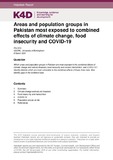| dc.contributor.author | Idris, Iffat | |
| dc.coverage.spatial | Pakistan | en |
| dc.date.accessioned | 2021-04-22T13:05:10Z | |
| dc.date.available | 2021-04-22T13:05:10Z | |
| dc.date.issued | 2021-03-08 | |
| dc.identifier.citation | Idris, I. (2021). Areas and population groups in Pakistan most exposed to combined effects of climate change, food insecurity and COVID-19. K4D Helpdesk Report 973. Brighton, UK: Institute of Development Studies. DOI: 10.19088/K4D.2021.058 | en |
| dc.identifier.uri | https://opendocs.ids.ac.uk/opendocs/handle/20.500.12413/16553 | |
| dc.description.abstract | There are strong interlinkages between the effects of climate change and natural disasters in Pakistan, food insecurity, and exposure to COVID-19. Areas/groups at risk of one will often be at risk of the others as well, demonstrating the complexities and multifaceted nature of vulnerability, risk, and exposure. In areas exposed to natural disasters, for example, there are likely to be higher levels of food insecurity. Key geographic areas at risk of the combined effects of climate change natural disasters and food insecurity in Pakistan are Balochistan, Sindh, southern Punjab, and parts of Khyber Pakhtunkhwa (KP). With the exception of Balochistan due to its very low population density, these are all also regions at high risk of COVID-19. Key population groups, especially at risk, are the poor and landless, and women. The poor, in particular, lack the capacity to adapt or recover from climate change impacts and natural disasters, face difficulties in accessing adequate food, and often live/work in conditions that promote transmission of COVID-19. This rapid review looks at areas and population groups in Pakistan most exposed to the combined effects of climate change and natural disasters, food insecurity and malnutrition, and COVID-19. The review draws on a mixture of academic and grey literature, including reports by development organisations. While considerable information was found about the diverse effects of climate change and natural disasters on different parts of the country (including down to district level), data on food insecurity was largely only at the provincial level. There are also significant gaps in the evidence base on specific population groups, notably religious minorities. | en |
| dc.description.sponsorship | FCDO (Foreign, Commonwealth and Development Office) | en |
| dc.language.iso | en | en |
| dc.publisher | Institute of Development Studies | en |
| dc.relation.ispartofseries | K4D Helpdesk Report;973 | |
| dc.rights.uri | https://www.nationalarchives.gov.uk/doc/open-government-licence/version/3/ | en |
| dc.subject | Climate Change | en |
| dc.subject | Population | en |
| dc.subject | Rights | en |
| dc.subject | Security and Conflict | en |
| dc.title | Areas and Population Groups in Pakistan Most Exposed to Combined Effects of Climate Change, Food Insecurity and COVID-19 | en |
| dc.type | Helpdesk | en |
| dc.rights.holder | © Crown copyright 2021 | en |
| dc.identifier.doi | 10.19088/K4D.2021.058 | |
| dcterms.dateAccepted | 2021-03-08 | |
| rioxxterms.funder | Default funder | en |
| rioxxterms.identifier.project | Default project | en |
| rioxxterms.version | VoR | en |
| rioxxterms.versionofrecord | 10.19088/K4D.2021.058 | en |
| rioxxterms.funder.project | 9ce4e4dc-26e9-4d78-96e9-15e4dcac0642 | en |

